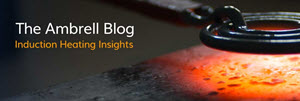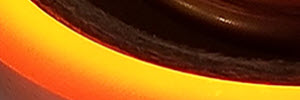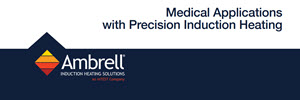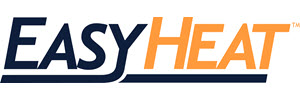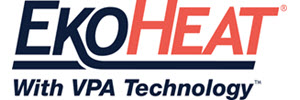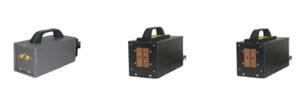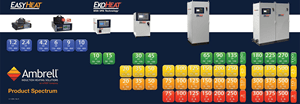Induction Heating for Medical Device Manufacturing
- Home
- How It's Used
- Medical Device Manufacturing
How is induction used for medical device manufacture?
Ambrell's induction heating systems provide medical device manufacturers with reliable, repeatable, non-contact heat, with control and accuracy focusing energy to a specific part area.
Induction generates an electromagnetic field in a work coil that induces currents in the conductive material of a workpiece placed within or near the coil. Friction from these currents elevates the temperature of the workpieces to be heated.
Benefits of Using Induction in Medical Device Manufacture
Induction meets tight production tolerances delivering precise localized heat to small areas creating pinpoint accuracy. The process increases production rates with faster heating cycles, reduces defect rates with repeatable, reliable heat and eliminates variability from operator-to-operator, shift-to-shift.
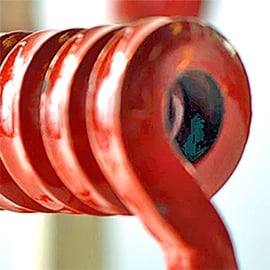
Medical Device Manufacturing Application Notes
Open panels to select from our libraries of notes
-
Annealing
 Annealing steel tubes in an inert atmosphere
Annealing steel tubes in an inert atmosphereInduction annealing heats steel tubes to 2000 °F (1093 °C) in an inert atmosphere for very small areas within precise production tolerances. A two-turn concentrator coil is used to heat the stainless steel tube. The annealing process takes place in an inert atmosphere to prevent oxidation.
 Annealing steel wire for a medical application
Annealing steel wire for a medical applicationInduction annealing achieved the targeted steel wire temperature within three seconds. Ambrell performed a free laboratory test, designed a cost efficient, in-house process and connected them with an automation partner to maximize productivity. The client now has better control over their end product.
 Annealing Stainless Steel Braids
Annealing Stainless Steel BraidsHeating took just 2-5 seconds depending on the sample used, meeting the client's requirements.
 Annealing a Stainless Steel Medical Wire
Annealing a Stainless Steel Medical WireSome process development may still be needed at the customer site once the induction system is delivered to account for the unique fixture/ handling techniques used
-
Bonding
 Bonding a plastic handle to a surgical knife
Bonding a plastic handle to a surgical knifeBonding handle of a stainless steel surgical knife into a plastic handle for very small areas within precise production tolerances
 Bonding Steel Tubes to Plastic Tubes with Induction
Bonding Steel Tubes to Plastic Tubes with InductionBonding with induction took just five seconds with our lowest power unit to deliver the bond just where it was needed.
 Bonding a stainless steel needle to a plastic shank
Bonding a stainless steel needle to a plastic shankA pancake/plate coil is used in this application. Ten assemblies are placed in the coil and power is applied for 1 second to melt the plastic to the stainless steel needle
 De-bonding Stainless Steel & Carbon Fiber Assembly
De-bonding Stainless Steel & Carbon Fiber AssemblyInduction heating process is more environmentally-friendly without the use of noxious chemicals
 Bonding Metal to Plastic for Dental Tools
Bonding Metal to Plastic for Dental ToolsReliable bonds are produced when the diameters of the preassembled parts are consistent with little clearance before they are heated.
 Bonding Metal Housings to Plastic Holders for Lenses
Bonding Metal Housings to Plastic Holders for LensesInduction heating improves processing quality by delivering uniform heat to two parts at once using a single-turn peanut' coil. Localized heat enables easy alignment of optical components during final assembly
For each size cannula, the power delivered to the part was optimized to create a bond between the cannula and its bushing, without discoloring the steel of the cannula or causing the bushing to become opaque
-
Brazing
 Brazing steel orthodontic parts
Brazing steel orthodontic partsA four turn helical coil is used to heat parts. Brazing paste is applied to orthodontic parts with a syringe...
To heat a steel tip and shank assembly to 1300 °F (704 °C) within 3 seconds for brazing with induction heating instead of torch brazing.
A C-shaped steel susceptor is used to ensure even heating and for ease of loading and unloading the samples.
 Brazing stainless steel medical tool parts
Brazing stainless steel medical tool partsInduction heating is used to achieve client's goal to braze both stainless steel parts as quickly as possible with maximum repeatability...
 Brazing stainless steel orthodontic begg brackets
Brazing stainless steel orthodontic begg bracketsA two turn oblong helical coil is designed to heat the steel brackets which are sandwiched between the two pieces of graphite.
 Brazing carbide to steel for a surgical device
Brazing carbide to steel for a surgical deviceCompared to a stick-fed flame braze heating, induction heating provides consistently higher quality joints. This is critical for medical applications.
-
Catheter Tipping
 Fuse thermoplastic catheter tubes
Fuse thermoplastic catheter tubesHeating of the mandrel is from the inside out providing a smooth finish on the outside of the assemblies.
To heat an aluminum catheter tipping die to above 285 °F within 2 to 5 seconds for the forming of catheter material.
 Heating a catheter tipping die
Heating a catheter tipping dieA two turn plate concentrator coil is used to heat the die. To measure the temperature on the ID and establish the time-to-temperature relationship...
Heat a water-cooled steel mandrel to 700 °F (371 °C) to form a high quality Teflon catheter tip.
 Plastic Reflow With Catheter Tubing
Plastic Reflow With Catheter TubingHeat a metal braid in a plastic catheter tube to 250 °F (121.1 °C) so that another catheter tube can be bonded to it.
-
Heating
 Heating an aluminum-backed circuit board - solder reflow
Heating an aluminum-backed circuit board - solder reflowGiven the significantly faster heating time, induction improves throughput in this process and is a more efficient heating method than hot plate heating
 Heating a copper end cap to melt wax
Heating a copper end cap to melt waxTo heat a copper end cap to temperature for a wax reflow application; the end product is a temperature stat and the client is looking to cut their heating time in half...
 Heating a nanoparticle solution to 40 °C
Heating a nanoparticle solution to 40 °CHeat a nanoparticle solution to get it to increase at least 40 °C for medical research/laboratory testing
 Heating iron oxide nanoparticle solution
Heating iron oxide nanoparticle solution An eight turn helical coil is used to heat the vials. 0.0625 thick insulation is wrapped around the vial and the vial is placed in the coil. The optical temperature probe is inserted into the vial with the base of the probe located in the middle of the coil turns.
 Heating susceptor for glass reflow (X-ray tubes)
Heating susceptor for glass reflow (X-ray tubes)A two turn helical coil is used for heating. Six graphite susceptors are placed in the nitrogen atmosphere with glass discs and a stainless steel holder.
 Heating solutions in vials for cancer research
Heating solutions in vials for cancer researchA four turn helical coil is used to heat the vial for 30 second intervals for five minutes with a temperature reading taken at each interval.
 Bonding a Gasket to a Sombrero Nut
Bonding a Gasket to a Sombrero NutA multi-turn pancake coil is used to preheat the nut. It is then transported to the next station where it is pressed onto a gasket for bonding
 Heat Setting A Shape Memory Alloy
Heat Setting A Shape Memory AlloyHeat a steel die to 975 °F (523.8 °C) to set (cure) a shape memory alloy nitinol in the correct position.
 Heating Steel Shafts for Forming (Medical Tools)
Heating Steel Shafts for Forming (Medical Tools)A custom-designed single position multiple-turn helical coil was built to generate the required heating for this application.
 Heating Surgical Tools for Coating Burn Off
Heating Surgical Tools for Coating Burn OffTo heat surgical tools to burn-off the nylon coating; the client had been using a torch for this application. Within seconds of the power being turned on, the coating on the tool began to smoke and soon started to bubble.
-
Soldering
 Soldering brass and copper (medical equipment)
Soldering brass and copper (medical equipment)This process is completed in two steps that use a 3 turn helical coil. The first process is to solder the brass ring to the copper piece which takes 85 seconds...
-
Annealing steel tubes
-
Catheter tipping
-
Molding
-
Plastic reflow
-
-
Brazing miniature medical parts
-
Soldering surgical tools
-
Nitinol shape setting
-
Curing powder coating
-
Metal to plastic insertion
-
Annealing tubes and surgical instruments
-
Hardening surgical instruments
-
Heating catheter tipping dies
-
Nanoparticle research
Popular medical device manufacturing Video
Popular medical device manufacturing Note
More medical device manufacturing resources
Headline
Add your content here.
Headline
Add your content here.
Headline
Add your content here.
Our Systems for medical device manufacturing with Induction
Headline
Add your content here.
Headline
Add your content here.
Headline
Add your content here.
Headline
Add your content here.
AMBRELL CORPORATION
1655 Lyell Avenue
Rochester, NY 14606
United States
![]() Directions
Directions
T: +1 585 889 9000
F: +1 585 889 4030
Contact Sales
Contact Orders
Contact Service
AMBRELL B.V.
Holtersweg 1
7556 BS Hengelo
The Netherlands
![]() Directions
Directions
T: +31 880 150 100
F: +31 546 788 154
Contact Sales
Contact Orders
Contact Service
AMBRELL Ltd.
Front Suite, 1st Floor, Charles House
148-149 Gt Charles Street
Birmingham, B3 3HT
United Kingdom
T: +44 1242 514042
F: +31 546 788 154
Contact Sales
Contact Orders
Contact Service


 Bonding Steel Cannulas
Bonding Steel Cannulas Brazing steel dental tools
Brazing steel dental tools  Brazing a heat-sensing probe
Brazing a heat-sensing probe Heating Catheter Tipping Die
Heating Catheter Tipping Die Molding a teflon catheter tip
Molding a teflon catheter tip